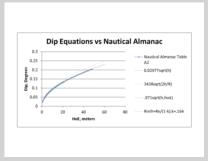
NavList:
A Community Devoted to the Preservation and Practice of Celestial Navigation and Other Methods of Traditional Wayfinding
From: Brad Morris
Date: 2013 Apr 7, 13:15 -0700
Hi Marcel
Since the Nautical Almanac is not readily available to you, I took the time to enter Table A2 into a spreadsheet such that I could compare the noted nominal equations to the gold standard. The Nautical Almanac has dip as a function of HoE, and provides that to HoE of 48 meters. Presumably it ends there because this is beyond the nominal HoE for marine navigation. Consider, Jeremy (one of those who posts here, a navlist correspondant) captains a large merchant ship and his HoE has been given as 103 feet (~31.3meters).
All equations, except one in particular are a very good fit to the data provided by the Nautical Almanac.
The only equation that does NOT fit is dip=3438*sqrt(2h/R). You can see that this one equation yields a dip that is simply too large in the attached chart. To see what would make 3438sqrt(2h/R) fit the gold standard, I changed the effective radius of the earth until it did. Rather surprisingly when k=.164, the equation meets the gold standard! You can see that in the line 3438sqrt(2h/Rrefr). [Not shown is a graph of pure geometric dip, which happened to precisely meet 3438sqrt(2h/R).]
To be sure I didn't misunderstand this equation, I referred back to Frank's post 122845 https://NavList.net/m2.aspx?i=122845 and re-examined his dip0 equation, where he states "R is the radius of the Earth and of course dip0=sqrt(2h/R)" and then "multiplying by 3438 to convert to minutes of arc ".
Instead of some snarky comments, I'll simply urge Frank to defend his post, and explain why ALL THE OTHER EQUATIONS MATCH THE NAUTICAL ALMANC FOR STANDARD ENVIRONMENTAL CONDITIONS EXCEPT FRANK'S APPROXIMATION. Dip for standard environmental conditions is simply NOT =3438sqrt(2h/R)
++++++
Now as to table A4. The instructions for table A4 are as follows:
"The graph is entered with arguments temperature and pressure to find a zone letter; using arguments of this zone letter and apparent altitude (sextant altitude corrected for index error and dip [Table A2]), a correction is taken from this table. This correction is to be applied to the sextant altitude in addition to the corrections for standard conditions (for the Sun, stars and planets from page A2-A3 and for the moon from pages xxxiv and xxxv).
Marcel, the top half is a graph of pressure versus temperature, with diagonal bands denoted by zone letters (see instructions). You find the intersection of your temperature and your pressure, yielding one of these zone letters. Next, you enter the table below, with the zone letter and apparent altitude (see instructions). There is clearly a row for altitude 0 degrees 0 minutes. The next row is for 0 degrees 30 minutes. Since our altitude is actually on the order of -3 to -12 minutes, it most closely fits with the first row. That first row shows corrections well beyond the temp and pressure corrections you derive from your method, as shown earlier in this discussion. That was the point I failed at making in an earlier post. The NA provides this correction table for non-standard conditions and the corrections are much larger than those provided by your method.
I understand your argument that this table refers only to astronomical refraction (a body like the sun or a star), and not to terrestrial refraction (the horizon under dip). You may indeed be correct. I'm simply not sure. I assumed that the bending of light from the horizon is identical to the bending of light from an object whose light is just at that horizon. I may very well be wrong.
ATTENTION TO NA EXPERTS
Please define if the Table A4 is exclusively for celestial bodies, or if it can indeed be used for objects like the horizon under non-standard environmental conditions. Has anyone an equation for Table A4?
Brad
----------------------------------------------------------------
NavList message boards and member settings: www.fer3.com/NavList
Members may optionally receive posts by email.
To cancel email delivery, send a message to NoMail[at]fer3.com
----------------------------------------------------------------







